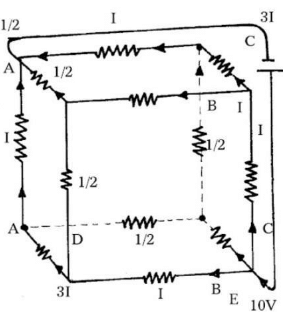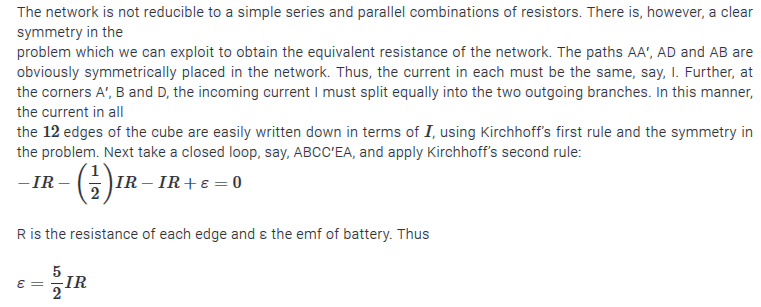Class 12 Exam > Class 12 Questions > A BATTERY OF 10V AND NEGLIGIBLE INTERNAL RESI...
Start Learning for Free
A BATTERY OF 10V AND NEGLIGIBLE INTERNAL RESISTANCE IS CONNECTED ACROSS THE DIAGONALLY OPPOSITE CORNERS OF A CUBICAL NETWORK CONSISTING OF 12 RESISTORS EACH OF 1OHM RESISTANCE. FIND THE EQUIVALENT RESISTANCE AND TOTAL CURRENT ?
Verified Answer
A BATTERY OF 10V AND NEGLIGIBLE INTERNAL RESISTANCE IS CONNECTED ACROS...



 This question is part of UPSC exam. View all Class 12 courses
This question is part of UPSC exam. View all Class 12 courses
Most Upvoted Answer
A BATTERY OF 10V AND NEGLIGIBLE INTERNAL RESISTANCE IS CONNECTED ACROS...
Problem:
A battery of 10V and negligible internal resistance is connected across the diagonally opposite corners of a cubical network consisting of 12 resistors, each of 1 Ohm resistance. Find the equivalent resistance and total current.
Solution:
To solve this problem, we need to determine the equivalent resistance and total current in the given network. We can break down the solution into the following steps:
Step 1: Identifying the Network:
The given network is a cubical network consisting of 12 resistors. Each resistor has a resistance of 1 Ohm. The battery is connected across the diagonally opposite corners of the network.
Step 2: Identifying the Diagonal Resistors:
Since the battery is connected across the diagonally opposite corners of the network, we can identify the diagonal resistors. In a cube, the diagonally opposite corners are connected by three mutually perpendicular diagonals. Therefore, each diagonal consists of 4 resistors.
Step 3: Identifying the Diagonal Resistors in the Network:
In the given network, we can identify three mutually perpendicular diagonals. Let's label them as diagonal A, diagonal B, and diagonal C. Each diagonal consists of 4 resistors. We can represent the network as follows:
```
A B C
|------| |------| |------|
| | | | | |
| 1 |---2---| 3 |---4---| 5 |
| | | | | |
|------| |------| |------|
|------| |------| |------|
| | | | | |
| 6 |---7---| 8 |---9---| 10 |
| | | | | |
|------| |------| |------|
|------| |------| |------|
| | | | | |
| 11 |--12---| 13 |--14---| 15 |
| | | | | |
|------| |------| |------|
```
Step 4: Reducing the Network:
To find the equivalent resistance, we need to reduce the given network. We can do this by replacing diagonal A, B, and C with a single equivalent resistor.
Step 5: Finding the Equivalent Resistance:
To find the equivalent resistance of the network, we need to calculate the resistance between the diagonally opposite corners of the cube.
Step 6: Applying the Formula:
In a cube, the resistance between diagonally opposite corners is given by the formula:
R_eq = 2 * (R1 + R2 + R3)
Since each resistor has a resistance of 1 Ohm, we can substitute the values in the formula:
R_eq = 2 * (1 + 1 + 1) = 2 * 3 = 6 Ohms
Therefore, the equivalent resistance of the network is 6 Ohms.
A battery of 10V and negligible internal resistance is connected across the diagonally opposite corners of a cubical network consisting of 12 resistors, each of 1 Ohm resistance. Find the equivalent resistance and total current.
Solution:
To solve this problem, we need to determine the equivalent resistance and total current in the given network. We can break down the solution into the following steps:
Step 1: Identifying the Network:
The given network is a cubical network consisting of 12 resistors. Each resistor has a resistance of 1 Ohm. The battery is connected across the diagonally opposite corners of the network.
Step 2: Identifying the Diagonal Resistors:
Since the battery is connected across the diagonally opposite corners of the network, we can identify the diagonal resistors. In a cube, the diagonally opposite corners are connected by three mutually perpendicular diagonals. Therefore, each diagonal consists of 4 resistors.
Step 3: Identifying the Diagonal Resistors in the Network:
In the given network, we can identify three mutually perpendicular diagonals. Let's label them as diagonal A, diagonal B, and diagonal C. Each diagonal consists of 4 resistors. We can represent the network as follows:
```
A B C
|------| |------| |------|
| | | | | |
| 1 |---2---| 3 |---4---| 5 |
| | | | | |
|------| |------| |------|
|------| |------| |------|
| | | | | |
| 6 |---7---| 8 |---9---| 10 |
| | | | | |
|------| |------| |------|
|------| |------| |------|
| | | | | |
| 11 |--12---| 13 |--14---| 15 |
| | | | | |
|------| |------| |------|
```
Step 4: Reducing the Network:
To find the equivalent resistance, we need to reduce the given network. We can do this by replacing diagonal A, B, and C with a single equivalent resistor.
Step 5: Finding the Equivalent Resistance:
To find the equivalent resistance of the network, we need to calculate the resistance between the diagonally opposite corners of the cube.
Step 6: Applying the Formula:
In a cube, the resistance between diagonally opposite corners is given by the formula:
R_eq = 2 * (R1 + R2 + R3)
Since each resistor has a resistance of 1 Ohm, we can substitute the values in the formula:
R_eq = 2 * (1 + 1 + 1) = 2 * 3 = 6 Ohms
Therefore, the equivalent resistance of the network is 6 Ohms.
Community Answer
A BATTERY OF 10V AND NEGLIGIBLE INTERNAL RESISTANCE IS CONNECTED ACROS...
R=5R/6=5*10/6=25/3 ohm
i=V/R=10/(25/3)=6/5 amp
i=V/R=10/(25/3)=6/5 amp

|
Explore Courses for Class 12 exam
|

|
Similar Class 12 Doubts
A BATTERY OF 10V AND NEGLIGIBLE INTERNAL RESISTANCE IS CONNECTED ACROSS THE DIAGONALLY OPPOSITE CORNERS OF A CUBICAL NETWORK CONSISTING OF 12 RESISTORS EACH OF 1OHM RESISTANCE. FIND THE EQUIVALENT RESISTANCE AND TOTAL CURRENT ?
Question Description
A BATTERY OF 10V AND NEGLIGIBLE INTERNAL RESISTANCE IS CONNECTED ACROSS THE DIAGONALLY OPPOSITE CORNERS OF A CUBICAL NETWORK CONSISTING OF 12 RESISTORS EACH OF 1OHM RESISTANCE. FIND THE EQUIVALENT RESISTANCE AND TOTAL CURRENT ? for Class 12 2024 is part of Class 12 preparation. The Question and answers have been prepared according to the Class 12 exam syllabus. Information about A BATTERY OF 10V AND NEGLIGIBLE INTERNAL RESISTANCE IS CONNECTED ACROSS THE DIAGONALLY OPPOSITE CORNERS OF A CUBICAL NETWORK CONSISTING OF 12 RESISTORS EACH OF 1OHM RESISTANCE. FIND THE EQUIVALENT RESISTANCE AND TOTAL CURRENT ? covers all topics & solutions for Class 12 2024 Exam. Find important definitions, questions, meanings, examples, exercises and tests below for A BATTERY OF 10V AND NEGLIGIBLE INTERNAL RESISTANCE IS CONNECTED ACROSS THE DIAGONALLY OPPOSITE CORNERS OF A CUBICAL NETWORK CONSISTING OF 12 RESISTORS EACH OF 1OHM RESISTANCE. FIND THE EQUIVALENT RESISTANCE AND TOTAL CURRENT ?.
A BATTERY OF 10V AND NEGLIGIBLE INTERNAL RESISTANCE IS CONNECTED ACROSS THE DIAGONALLY OPPOSITE CORNERS OF A CUBICAL NETWORK CONSISTING OF 12 RESISTORS EACH OF 1OHM RESISTANCE. FIND THE EQUIVALENT RESISTANCE AND TOTAL CURRENT ? for Class 12 2024 is part of Class 12 preparation. The Question and answers have been prepared according to the Class 12 exam syllabus. Information about A BATTERY OF 10V AND NEGLIGIBLE INTERNAL RESISTANCE IS CONNECTED ACROSS THE DIAGONALLY OPPOSITE CORNERS OF A CUBICAL NETWORK CONSISTING OF 12 RESISTORS EACH OF 1OHM RESISTANCE. FIND THE EQUIVALENT RESISTANCE AND TOTAL CURRENT ? covers all topics & solutions for Class 12 2024 Exam. Find important definitions, questions, meanings, examples, exercises and tests below for A BATTERY OF 10V AND NEGLIGIBLE INTERNAL RESISTANCE IS CONNECTED ACROSS THE DIAGONALLY OPPOSITE CORNERS OF A CUBICAL NETWORK CONSISTING OF 12 RESISTORS EACH OF 1OHM RESISTANCE. FIND THE EQUIVALENT RESISTANCE AND TOTAL CURRENT ?.
Solutions for A BATTERY OF 10V AND NEGLIGIBLE INTERNAL RESISTANCE IS CONNECTED ACROSS THE DIAGONALLY OPPOSITE CORNERS OF A CUBICAL NETWORK CONSISTING OF 12 RESISTORS EACH OF 1OHM RESISTANCE. FIND THE EQUIVALENT RESISTANCE AND TOTAL CURRENT ? in English & in Hindi are available as part of our courses for Class 12.
Download more important topics, notes, lectures and mock test series for Class 12 Exam by signing up for free.
Here you can find the meaning of A BATTERY OF 10V AND NEGLIGIBLE INTERNAL RESISTANCE IS CONNECTED ACROSS THE DIAGONALLY OPPOSITE CORNERS OF A CUBICAL NETWORK CONSISTING OF 12 RESISTORS EACH OF 1OHM RESISTANCE. FIND THE EQUIVALENT RESISTANCE AND TOTAL CURRENT ? defined & explained in the simplest way possible. Besides giving the explanation of
A BATTERY OF 10V AND NEGLIGIBLE INTERNAL RESISTANCE IS CONNECTED ACROSS THE DIAGONALLY OPPOSITE CORNERS OF A CUBICAL NETWORK CONSISTING OF 12 RESISTORS EACH OF 1OHM RESISTANCE. FIND THE EQUIVALENT RESISTANCE AND TOTAL CURRENT ?, a detailed solution for A BATTERY OF 10V AND NEGLIGIBLE INTERNAL RESISTANCE IS CONNECTED ACROSS THE DIAGONALLY OPPOSITE CORNERS OF A CUBICAL NETWORK CONSISTING OF 12 RESISTORS EACH OF 1OHM RESISTANCE. FIND THE EQUIVALENT RESISTANCE AND TOTAL CURRENT ? has been provided alongside types of A BATTERY OF 10V AND NEGLIGIBLE INTERNAL RESISTANCE IS CONNECTED ACROSS THE DIAGONALLY OPPOSITE CORNERS OF A CUBICAL NETWORK CONSISTING OF 12 RESISTORS EACH OF 1OHM RESISTANCE. FIND THE EQUIVALENT RESISTANCE AND TOTAL CURRENT ? theory, EduRev gives you an
ample number of questions to practice A BATTERY OF 10V AND NEGLIGIBLE INTERNAL RESISTANCE IS CONNECTED ACROSS THE DIAGONALLY OPPOSITE CORNERS OF A CUBICAL NETWORK CONSISTING OF 12 RESISTORS EACH OF 1OHM RESISTANCE. FIND THE EQUIVALENT RESISTANCE AND TOTAL CURRENT ? tests, examples and also practice Class 12 tests.

|
Explore Courses for Class 12 exam
|

|
Signup for Free!
Signup to see your scores go up within 7 days! Learn & Practice with 1000+ FREE Notes, Videos & Tests.



















